| Article ID | Journal | Published Year | Pages | File Type |
|---|---|---|---|---|
| 9032216 | NeuroToxicology | 2005 | 7 Pages |
Abstract
In glial cells, glutamate exposure causes alterations in cell redox status, mainly mediated by glutathione depletion and reactive oxygen species generation. These effects finally lead to astrocyte dysfunction which contributes to the pathogenesis of several neurological disorders. This study was aimed to investigate the involvement of the NF-κB pathway in oxidative stress induced by glutamate exposure in primary cultures of astrocytes. Further, we evaluated the power of the antioxidants genistein (0.1-10 μM) and IRFI 016 (20-80 μM), a synthetic tocopherol analogue, compared with glutathione ethyl ester (10-50 μM) and cysteamine-HCl (100-500 μM), to antagonize the effects elicited by glutamate (500 μM). Alterations of cell redox status were reduced, in a dose-dependent way, by antioxidants; in particular, 80 μM IRFI 016 and 10 μM genistein almost completely restored glutathione basal levels and significantly diminished ROS production, as well as 100 μM glutathione ethyl ester. These antioxidant effects were stronger than those caused by 500 μM cysteamine-HCl. Further, glutamate promoted the up-regulation of p50 and p65 NF-κB subunits and their nuclear translocation, as revealed by Western blot analysis and electrophoretic mobility shift assay of both subunits. The activation of p50 and p65 NF-κB subunits induced by glutamate exposure was significantly reduced by IRFI 016, acting in a dose-dependent manner. Altogether, these data confirm that the NF-κB pathway is involved in cell response to oxidative stress induced by glutamate injury in primary astrocyte cultures, and suggest that the use of antioxidants, such as IRFI 016, may be a helpful pharmacological strategy for neuroprotection.
Keywords
NF-κBEMSA2′-7′-dichlorofluoresceinDCFDAHRPDcfFITC3-(4,5-dimethylthiazol-2-yl)-2,5-diphenyl tetrazolium bromideGSH/GSSGMTTROSElectrophoretic mobility shift assayPrimary astrocytesROS productionfluorescein isothiocyanateGenisteinHorseradish peroxidaseGlutathionereduced/oxidized glutathioneglutamateReactive oxygen species
Related Topics
Life Sciences
Environmental Science
Health, Toxicology and Mutagenesis
Authors
Daniela Caccamo, Agata Campisi, Monica Currò, Vincenzo Bramanti, Michelangelo Tringali, Giovanni Li Volti, Angelo Vanella, Riccardo Ientile,
